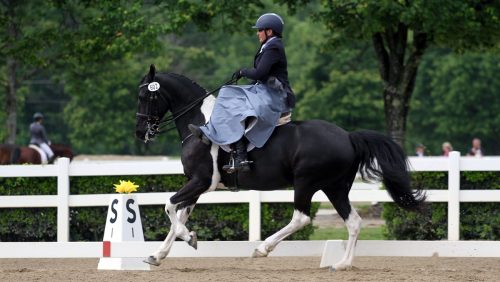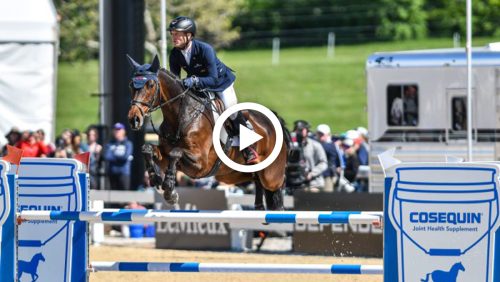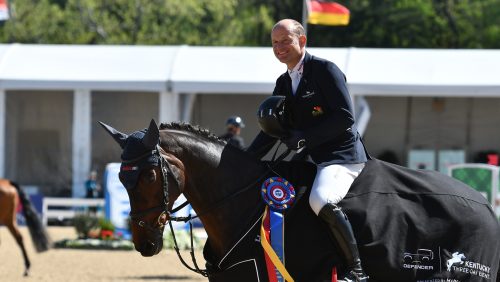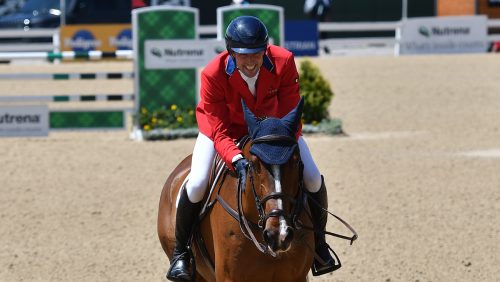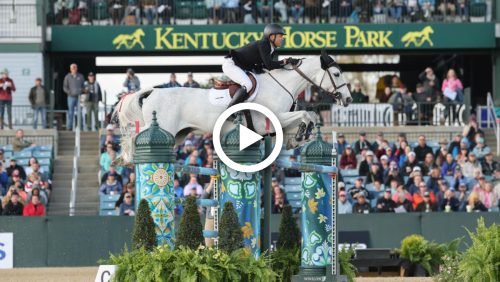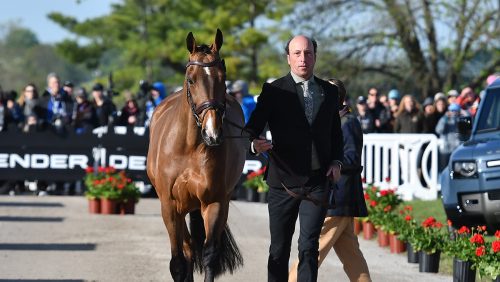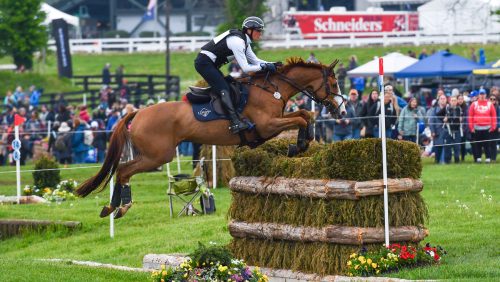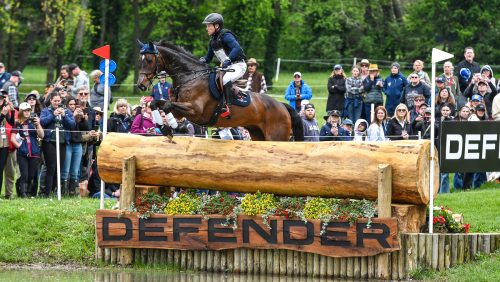Riding hunters is not easy. Few people teach strictly hunters, and fewer people teach it well. It is a very difficult vocabulary, and is easy to interpret incorrectly.
There are too many components, which is mainly the reason so many drugs are used, and now we face a crisis with Carolina Gold, GABA, Perfect Prep, Dormosedan, and whatever else being used to quiet a horse down and people jumping to conclusions about all hunters using medication to compete.
It makes buyers nervous to purchase horses actively showing, which doesn’t help the sport, doesn’t grow the sport, and also inherently leads to an enormous amount of friction between the U.S. Equestrian Federation and its members.
It is so hard for the right people to stand up to cheaters because in the back of their minds, they could possibly be selling the next winner to them down the road. And they might need the money! Hello? Calling a cheater out is painful and really impossible in this day and age.
The show hunter sport sure could use a facelift.
Many more people have to longe horses, or the horses MUST get schooled from a professional before being handed off to an amateur or junior. This is not a bad thing, just the way it is right now.
However, there is definitely a growing number of people who would prefer not to have to spin their expensive animal in a tiny circle for an hour before it heads to the ring. People infuriate me constantly when they criticize riders or trainers with hot horses, spewing things like “you should have picked a better horse,” or “just buy something quieter.”
Like “disposable horses” is something we should be encouraging. This happened at the last U.S. Hunter Jumper Association convention I attended, and I could feel my face turning red, my blood pressure rising. It was unproductive and dismissive. The great GM would say the same thing. “Change that chestnut mare for something you can actually ride!”
It is not a sentiment I want to continue to hear anymore.
Meanwhile, hunter clinics are almost non-existent in today’s real world.
So what if we could invite an entire culture to re-learn how to ride a show hunter? The next generation? Would anyone be interested? Maybe a few, if taught properly. I know the horse is being judged, but the rider is responsible for the horse looking good, great, or normal, and everything in between.
I find there are a ton of people who give up riding hunters after years of frustration, only to find relaxation and exuberance in the jumper ring. Ride for a clean round, then ride for speed. No one can really blame them, can they?
I also like riding in the jumper ring and even moved to Europe for a while to feed my inner “go fast, jump high” child inside of me, but honestly, I ride hunters well, my body understands hunters, and even if at times, going around in circles is incredibly tiresome and dull, I get it.
It is an art. It is magical; people notice it. They do. We do. People notice when they are watching something incredibly difficult look soooooooo easy, so, so easy. Ironically, last year I posted a video of Tori Colvin’s junior hunter round receiving a perfect score at Upperville (Va.), and it received over 40,000 hits. I was dumbfounded and impressed at the same time. I think that recognition of beautiful riding and beautiful form from the horse is what keeps me doing it; besides the fact that if you can find a few good hunters to sell, the money is not bad.
When I searched the web for instructional tools for hunters, I came up short. I noticed fun things like how to do a lead change, many dressage tutorials, eventing tutorials, equitation secrets, but the hunter information is lacking. We need show hunter information in order to keep the hunters relevant to our horse show world, but it is hard to find and never free.
There are so many things I have learned over the years from teaching new people how to ride better that fascinated me. No less than 80 percent of what I taught was entirely NEW information. Have instructors recycled certain teaching habits so much that there is little innovative language for hunters?
What am I talking about? The perfect distance, for example? WTF? Why can’t people generally create their own distance to a fence?
It is all I hear from students: the desire to find the perfect distance. I don’t understand how it can be left up to luck to get to the perfect distance. Math is involved. Course designers set a very mathematical pattern in a ring that is supposed to be followed, on a 12-foot stride (for a horse).
Do you understand how many strides you are supposed to get in a 72-foot line or do you just hope your trainer tells you the right thing when you are standing at the in-gate? I am not saying the perfect chocolate chip shouldn’t ever happen, because even the best riders miscalculate the math and what is happening inside their horse’s brains, but many chocolate chips can be prevented with more information. Knowing how to count strides is simply part of hunters 101. In a 72-foot line for the 3’ hunters, you generally have three options—four strides (scary) or five strides (correct) or six strides (the add). The 72’ line in any ring anywhere should ride the same.
I want hunters to stick around. I think they are generally pretty, I think the challenge of a good hunter round is worth rewarding, I think we have a lot to gain for having hunters in our business, our industry, our sport, and I want a healthy relationship for hunter judges and competitors as well, without the weird brotherhood up the line we keep hearing about.
It is education, it is tolerance, it is going to take a village. It is going to take mentors being really good mentors. it is about seasoned judges allowing up-and-coming judges to understand that even if mistakes are made they will still receive education, not be punished or not hired. Maybe even the politics can fade out if we do this properly.
ADVERTISEMENT
I would like to see more young professionals feel like they have a chance at really big competitions. Helping each other to help the sport.
So what can I offer? The experiment, which undoubtedly someone else will perfect later down the road.
I don’t know if this is much, but it certainly has helped a lot of people in the past. Just for a moment I want to skip ahead to jumping over flatwork (which I am a strong believer in). If you are not doing all the moves on your hunter that an upper level dressage rider is doing with a horse, you are not doing it right. Lengthen, collection, lateral work, perfect transitions, etc., etc.
And all of these moves should happen before you actually step over your first jump. However, I am not an idiot. I know we get in a hurry to get to the show ring.
There are multiple types of hunters out there. This first one to address is a horse with its own motor.
Approximately 90 percent of new riders I have come across “encourage” a horse to leave the ground at an obstacle.
Why do you tell your horse to jump a fence when it is already OK with jumping said fence? It is not spooking at it, not balking, not green, not behind your leg. It is already like, “Sure mom, let’s do this!” and yet, as a rider, you are adding energy to the take-off.
No one wants you to add energy to the take-off in a hunter round! Please add LESS energy as your horse gets closer to the fence. Let your body breathe, melt, put your heels down, take your leg off, and RELAX.
Have you ever heard the phrase “let the horse jump up to you?” LET THE HORSE JUMP UP TO YOU. Smoothly, on its own, in breathtaking fashion. Make the jump last forever. Pretend someone is trying to photograph that perfect moment and hold still.
Loads of people will argue with me all day long, criticize how I look, what I am doing, but in general, what I do works, and other people can do it, too.
Do I understand that hunters are judged on their own form and #kneesup, but the rider is not being judged? Yes, of course I do!! But I also know first hand that I AM AFFECTING HOW THAT HORSE PRODUCES A PERFECT ROUND. My body is equally responsible for a good hunter being a good hunter in the show ring. #TheRiderMatters
A: Create a trot jump (crossrail) with a take-off pole 6 feet in front of the jump in your ring.
B: Approach said trot jump. As you step over the pole in front of the jump, push your heel toward the shoulder of the horse and try to touch said shoulder. You can’t actually physically do this, no one can, but the action is what moves your leg to a better position over top of the cross rail. Your heel goes further down, away from the horse’s side, and you have successfully not encouraged your horse to jump, and are allowing him to jump to you.
If your horse is over the age of 6, he probably already knows what to do, correct? Get to the other side? So, stay out of the way! You have other things to worry about next.
Now many other variables come into play during the process, like release, seat, momentum, body control, but the general idea is the same for your leg every time: heels down, away from the horse.
Body position over a jump for a hunter rider. Often misinterpreted, rarely duplicated.
The SECOND most misused part of the body is the torso in mid-air over a jump in the hunter ring.
Riders, for some reason, totally get into jumping. They want to jump more than their horses do! You see SO MANY RIDERS FLINGING their torsos over the jump in such dramatic fashion, you would think they were at the Olympic Games jumping 1.60-meter, but in reality it is a 2’6” or 3’ children’s or adult hunter class.
Slow down sista. Let that beast jump up to you.
He is doing all of the work; please do not add to the magic. If you have perfected that leg thing up above, chances are pretty strong you can also smoothly allow your body to be following the horse in slow motion over top of a jump.
Riders who jump with their bodies work very hard. Too hard. You see torsos twisting, elbows flapping, ducking, too much energy, whatever it is, it is too much. Hunt Tosh does not work very hard. He ALLOWS his body to just follow along and bend over slowly, smoothly, magically, until he lands on the other side. He has mastered the TWO-POINT position, is ready when needed to stay in that position, and his horses are ALWAYS jumping up to him. It is EASY for him.
ADVERTISEMENT
To perfect this body position, try this:
A: Create that same trot jump I mentioned above. Perfect that leg position and heels down moment over top of the jump. For like a week. Or 10 weeks.
B: As your horse steps over the pole, SLOW DOWN the momentum of your body bending over in the air over top of the crossrail. It is almost like not bending over much at all, it is only a SLIGHT bend to the waist, relaxing, thinking about your heel down, magical, slow, and allowing your horse to jump up to you.
Your elbow should feel squishy, light, and follow the horse’s mouth during the release, then rest back at your ribcage. I like to call it ELASTIC ELBOW.
Let your beautiful beast do all the work, show him/her off, let him/her be amazing. On a trot jump, it is kind of like finding the high part of your post and letting your arms simply follow through to the landing.
I was told several years ago, by the very prominent hunter trainer Jack Stedding, Sr., that a trot crossrail in-and-out to an oxer is all you need to perfect timing, balance, scope, strength, body control, athleticism, form, style and basically ALL of the things hunters need to be successful.
At first, my skepticism kept me from believing in this idealism. How could TWO JUMPS make a champion?
Yet, he is absolutely right, those two jumps can cover all rider errors and horse errors, and change them from losers into winners with enough repetition and accuracy. It actually does make a hunter a champion.
He should know, he produced dozens and dozens of winners. And it does make a rider invaluable.
So after working on that crossrail, measure 18’ and place the next fence, starting with a vertical, and ending up with an oxer. The oxer can vary in height up or down, Swedish, ramped or square.
I took two horses and broke it down as best as I could manage. This first video follows the leg. I am using the pole to remind myself to step down on the stirrup as I step over the pole, with my heel dropping lower so I am not “encouraging” my horse to jump, just allowing.
This second video follows the body control and degree of “bending over” in the air over a jump. Everyone has a particular style; I prefer to keep mine as simple as possible. As straight as possible. I like my torso to allow my horse to come to me, rather than dive down to him.
This final video shows a few single jumps with each horse trying to put it all together. Hopefully it translates well enough, and again I don’t mind if people disagree with my particular style. It works for me, I think it can work for others, too.
Maybe you are thinking, well, those are only two variables out of 150. True. I could write a book on the 148 others, but I prefer to blog about it. Good hunter horses need good hunter pilots.
So as you scratch your head and wonder where I am going with this, try to keep in mind I, along with a few other professionals in the sport/industry, would like to see hunter horses continue to flourish and not disappear.
I am WILLING to teach more people in order to not lose riders to the jumper ring. I want to see free clinics offered throughout the country that focus solely on hunters. Am I selfish? Yes, of course, because as I watch countless sale horse videos on YouTube, I am thinking, “Who can I sell the next hunter prospect/winner to? Who wants the next special derby horse?”
It is a business, as well as a sport, and it is up to us to keep it alive. We can produce, we can maintain. We can win.
Hunter/jumper trainer Deloise Noble-Strong runs her business out of her family farm in Upperco, Md. She follows in the footsteps of many generations of horsemen in her family. Deloise has spent time living in Belgium, Holland and Germany and imports, trains and sells many hunter prospects. She also speaks her mind on her personal blog, Deloise In America.







